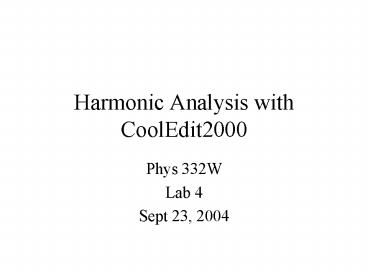Harmonic Analysis with CoolEdit2000 PowerPoint PPT Presentation
1 / 9
Title: Harmonic Analysis with CoolEdit2000
1
Harmonic Analysis with CoolEdit2000
- Phys 332W
- Lab 4
- Sept 23, 2004
2
- Goals
- To familiarize yourself with the tools of
harmonic analysis in CoolEdit2000. - To analyse the harmonic structure of several
tones from a single real sound source. - Equipment
- Musical instrument Voice, Recorder, Guitar,
Keyboard, CD recording, - Computer with CoolEdit
- Initialization
- Launch CoolEdit
- From the Options menu, select Monitor Record
Level - From the Options menu, select Windows Mixer
- From the View menu, select Show CD Player
3
- CoolEdit Initialization, contd
- In Windows Mixer, select source for recording
- In Volume Control, select Options, Properties,
Recording - Select your sound source
- Microphone
- Line-in (keyboard, etc)
- CD Recorder
4
Recording
- Record several seconds of music.
- Use sample rate44100
- Mono or Stereo, 16 bit
- Select a single note, and highlight it with the
cursor. - In the Analyze menu, select Frequency Analysis.
- Select FFT size 32768, Blackman-Harris, and hit
Scan - Use the cursor in Frequency window to get exact
frequencies and amplitudes (dB) of major
intensity maxima
Find the peak frequencies by matching the db
reading in the cursor window with the value on
the vertical axis.
5
Here are sample frequency data from the downbeat
of the second movement of the J.S. Bach 1st
Violin Concerto
If you open the exel file, on Sheet-1 you can see
the excel formula for computing the trendline
(straight-line fit). The magenta points are 10
times the difference between the data and
trendline (simple integer multiples of
fundamental.
6
J.S. Bach 1st Violin Concerto, 1st Movement
7
Here are sample frequency data from the downbeat
of the first movement of the J.S. Bach 1st Violin
Concerto
This is the same exel file. On Sheet-2 you can
see the excel formula for computing the trendline
(straight-line fit). Notice that is is a chord,
the first few harmonics are not multiples 1,2,3
of the funadamental but 5/4, 3/2, 4/2, 5/2
multiples. The magenta points are 10 times the
difference between the data and trendline
8
Proceedures
- Record 2 different notes from 2 different
instruments. - Make a note (on paper or in excel spreadsheet if
you have a disk) of the frequencies and
intensities of the first 5 strong harmonics you
observe. - Comment on any changes you observe in the spectra
if you change the filter type (Gauss, Welsh,
Blackman-Harris), or FFT size (2048-32768). - Are the frequency peaks narrower or broader?
- Is there more or less noise?
- Comment on any difference you observe from
different sound sources - Harmonics more/less well defined.
- Pitch/frequency peak sharper or broader.
9
Write-up
- Make a plot of your frequency values first simple
integer or rational estimates of the
overtone/chord frequencies - Compute and tabulate the difference between each
of your overtone frequencies, and some simple
integer or rational (5/4, 3/2,) multiples of the
fundamental. - Comment on how closely in tune these overtones
are. - One musical half step is a 6 change in frequency
- Two pitches f1 and f2 (including a phantom
overtone) will beat (oscillate in amplitude) with
frequency f1-f2. - If (f1-f2)/(f1f2) lt 0.02 this produces tremulo
- If (f1-f2)/(f1f2) gt 0.02 this produces a
clashing dissonant sound. - A more sophisticated way of doing this is
calculating residuals in excel.

